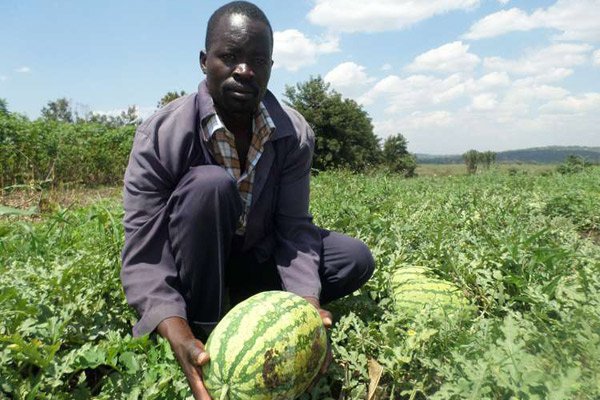Benjamin Odhiambo, 34, grows watermelons in Kochila, Homa Bay County.
The farmer, though is struggling with a stubborn pest that has seen him burn his fingers, more than once.
It all started sometime in early 2006. Having heard that watermelon fetches good money, he went for it with passion.
He put his two acres under the crop, the father of three narrates, adding he had raised a capital of Sh120,000 from his savings and injected it into the venture.
“I started with 0.25 acre with 800 seedlings of Sugar Baby variety in February 2006 and harvested about 80 fruits in late April making sales of Sh23,000,” recounts the teacher.
This success saw him plunge deeper into the venture, putting more land under the crop. With little knowledge on basics of growing melons, however, hell broke loose for Odhiambo when he suffered a severe attack by aphids and floods.
“Aphids attacked my melons and floods later swept away the crop, making me to suffer a huge loss. I had planted 500 seedlings of Sugar Baby variety but harvested nothing,” says Odhiambo, adding the pesticides such as Actara and Considor help eliminate aphids.
He abandoned growing melons for some years, but when he saw good returns other farmers in the area were enjoying, he decided to give it a try once again.
“I consulted agriculture officers who advised me on how to prepare the farm and the best varieties suitable with the soil on my farm. I planted the 600 Raha F1 seedlings after attending a week’s training courtesy of a horticulture company.”
Upon harvest, Odhiambo earned Sh80,000 after getting 300 fruits and selling them in markets in the region, boosting his confidence in expanding the business on an additional one acre plot he had acquired.
In 2014 he planted 3,000 Sukari F1 seedlings, but he suffered another loss he estimates at about Sh150,000 due to melon fly attack. To date, he still struggles with the pest, losing fruits to it despite applying pesticides.
Unlike aphids, the female melon fly attacks young fruits, sucks the juice and breeds its eggs in the fruit, deforming and making it rot. “A single melon fly can lay up to 1,000 eggs in a fruit. Once it completes laying the white eggs in one fruit, it moves to the next,” says the farmer, noting constant spraying with Thunder and other chemical enables him fight off the pest and make some income.
Melon do well in warm areas, well-drained soils with minimal irrigation and mature in 75 days.
The farmer usually plants the seedlings he buys from agrovets in clear polythene tubes for eight days before transplanting to the open field. The seedlings are planted each a metre apart and he uses NPK fertiliser.
Odhiambo harvests the fruits when they hit between 6kg and 14kg, and sells at Sh25 a kilo to traders at Kibuye market in Kisumu town and others in Homa Bay and Migori counties.
Prof Paul Kimurto, a crops’ expert at Egerton University, explains that the melon fly is a huge threat to the fruit.
“Melon fly larvae cause watermelons to turn into a soft, mushy mess because of adult flies that have laid eggs in the flesh of ripening and ripe melons.”
Once the eggs are hatched, the larvae begin to feed within the fruit, causing it to ripen prematurely, rot and drop to the ground.
As a remedy, he suggests farmers can use pheromone traps suspended onto the fruit in the farm.
“The pheromone is a hydrolysed protein bait solution, which has amino and organic acids to attract melon flies inside the trap.
The flies then drown in the trap with no means of getting outside,” he says, noting, however, the traps may be hard to come by for rural farmers.









Do you offer market opportunities to farmers.